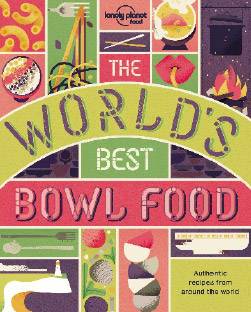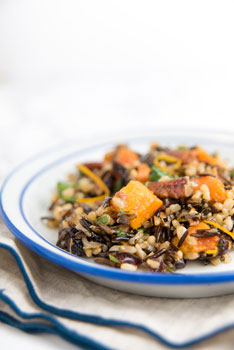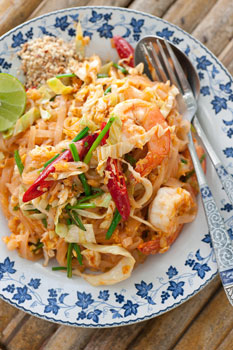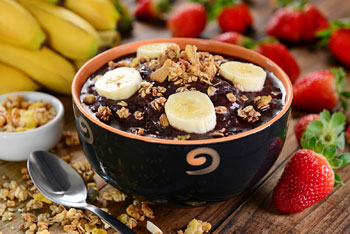Lonely Planet Food's The World's Best Bowl Food

Discover 100 one-pot recipes from cultures around the globe with Lonely Planet Food's The World's Best Bowl Food.
The new book is divided into six chapters:
Breakfast Bowls
Soups
Salads & Healthy Bowls
Rice, Pasta & Noodles
Stews, Braises & Hearty Bowls
Desserts
46 destinations are represented in the book, with recipes that will set you up for the day, warm the core or humbly feed friends and family. Explore the culture and cooking methods behind the planet's most comforting meals with recipes for dishes such as Beouf bourguignon (France), Bibimbap (Korea), Red bean tagine (Morocco), Waldorf salad (USA) and Eton mess (England). All recipes in the book are rated easy, medium or hard to re-create and include tasting notes and information about the origins of the dish.
It's no coincidence that some of the world's very best edible offerings come in a bowl. There's just something hearty, wholesome and inviting about spheres of steaming soup, colourful poké, and aromatic pho that plating up can't match, so get ready and dig in!
This is the fifth release in Lonely Planet Food's The World's Best… series of food & drink books, following The World's Best Street Food (2012), The World's Best Spicy Food (2014),The World's Best Drinks (2016) and The World's Best Superfoods (2017).
Lonely Planet Food's The World's Best Bowl Food
Lonely Planet
RRP: $24.99
 Wild Rice and Sweet Potato Power Bowl – USA
Wild Rice and Sweet Potato Power Bowl – USA
Nary a lettuce or empty calorie in sight, this New York power salad energises and nourishes with every tasty bite.
Serves 2
Ingredients
2 tbs olive oil
1 cup wild rice
salt and pepper
1 medium avocado, pitted
juice of 1 lime
1 small garlic clove, peeled and minced
½ cup canned chickpeas
1 bunch of radishes, trimmed and thinly sliced
1 bunch of watercress, trimmed
1 cup roast chicken (optional)
2 tbs sunflower seeds
Method
Preheat the oven to 200°C (400°F).
Spread the sweet potato on a rimmed baking sheet, drizzle with 1 tbs of olive oil and season with salt and pepper. Bake in the oven for 20 minutes or until soft.
Cook the rice according to the packet instructions until just tender, then set aside.
To make the dressing, combine the avocado, lime juice, garlic and remaining olive oil in a small bowl. Whisk in a little water to thin the dressing to your desired consistency, and season with salt and pepper.
To serve, put some rice in a bowl, top with the sweet potato and remaining ingredients and drizzle generously with the avocado dressing.
Tasting Notes
One of the world's most dynamic and diverse food cities, New York is home to a staggering concentration of eating destinations, including a proliferation of chain and, more recently, pop-up establishments specialising in healthy bowl meals. A classic New York power bowl is a well-balanced blend of grains, vegetables and lean proteins, as well as a tasty way to eat local, sustainable and seasonal ingredients. No longer the domain solely of salad bars, power bowls are everywhere and the variety is seemingly endless, from burrito bowls to meat and three veg. Unsurprisingly, they're particularly popular with city workers and exercise devotees looking for nutritious, filling and novel options for breakfast, brunch and lunch.
Origins
The emergence of bowl food as -the new salad' in New York most certainly stemmed from its enthusiastic adoption by upscale salad chains and juice bars. A modern phenomenon, it nevertheless finds its roots in the principles of the macrobiotic diet that burst on to the food scene of the 1960s, encouraging not just healthy food choices but a positive mental outlook and an active lifestyle. Time-poor and wellness-obsessed New Yorkers embraced these wholesome qualities and inspired a social media movement.
 Phat Thai – Thailand
Phat Thai – Thailand
Phat thai is the most famous Thai dish in the world, and understandably so: you can't go wrong with gooey strands of noodles, crunchy peanuts, tart lime and singed egg.
Serves 4
Ingredients
4 tbs tamarind concentrate
6 tbs palm sugar
2 tbs fish sauce
5 tbs peanut (groundnut) or vegetable oil
8 red shallots, peeled and coarsely chopped
3 duck eggs
320g (11oz) fresh rice noodles; or 260g (9oz) dried rice noodles, blanched in boiling water
50g (2oz) firm tofu, cut into cubes
2 tbs dried prawns (shrimp), rinsed and dried
1 tsp salted radish, rinsed, dried and finely chopped
2 tbs roasted peanuts, coarsely chopped
2 handfuls of beanshoots, trimmed
1 handful of Chinese chives, sliced into 2.5cm (1in) lengths
extra beanshoots and roasted peanuts, fresh chillies and lime wedges, to serve
Method
Mix the tamarind concentrate with the palm sugar and fish sauce until the sugar dissolves. Set aside.
Fry the shallots until they begin to colour.
Crack in the eggs and stir them until they resemble scrambled eggs.
Turn up the heat and add the blanched noodles. Add the tamarind mixture and let it simmer for a few minutes.
Stir in the tofu, dried prawns, radish and peanuts and continue stirring until most of the sauce is absorbed.
Add the beanshoots and chives and stir for a few minutes.
Transfer to a bowl, top with more beanshoots and roasted peanuts and serve immediately with fresh chillies and lime wedges on the side.
Tips:
Have all the ingredients prepared and ready to go next to your wok as the dish takes very little time to cook.
The duck eggs may be substituted with chicken eggs, and the red shallots with French shallots or brown onions but the rest of the ingredients are key to the dish's salty, sweet and sour taste, and should be readily available from Asian supermarkets.
Tasting Notes
Although nowadays phat thai is sold in restaurants, it's still an important part of the street-food repertoire. Stalls selling the noodles also tend to serve hoy thot, a mussel omelette. Both are generally fried on the same flat, round surface, but some vendors choose to fry phat thai in a wok. Phat thai is among the milder Thai street dishes and diners are expected to boost the flavour with a personalised mixture of fish sauce, sugar, dried chilli and ground peanuts. Served with sides that possess a slightly bitter taste, including banana flower and garlic chives, true phat thai is a largely vegetarian dish containing only dried shrimp and fish sauce, although modern versions sometimes include fresh prawns or shrimp.
Origins
Phat thai, which allegedly dates back to the 1930s, is a relatively recent introduction to the Thai kitchen and, despite the nationalistic name, is in many ways more of a Chinese than a Thai dish. Both noodles and the technique of frying are Chinese in origin, although the dish was invented in Thailand and its seasonings are characteristically Thai. Today, it is quite possibly Thailand's most beloved culinary export and remains a popular one-dish meal in Bangkok and central Thailand.
 Açaí Bowl – Brazil
Açaí Bowl – Brazil
It looks like ice cream, and tastes like ice cream, but this tropical Brazilian superfood snack couldn't be healthier. Refreshingly cool and satisfyingly filling, it's heaven in a bowl.
Serves 2
Ingredients
2 heaped tbs freeze-dried açaí powder or about 110g (4oz) slightly thawed açaí pulp
2 heaped tbs milled seeds (chia, flax, sunflower etc)
⅔ cup almond milk, coconut milk, coconut water or apple juice
1½ cups frozen blueberries and/or sliced banana
For the toppings:
⅔ cup fresh seasonal berries and/or figs
1 ripe banana, sliced
4 tbs muesli or oats
2 tbs seeds or other toppings (try flaxseed, chia seeds, shredded coconut, jungle peanuts and/or bee pollen)
Method
Blend the açaí powder/pulp with the milled seeds, liquid and frozen fruit.
Add more liquid until it reaches the desired consistency, according to your personal taste. Transfer the mixture to a breakfast bowl.
Top the mixture with fresh berries and/or figs, sliced banana, muesli (or oats) and seeds, in whichever combination you prefer.
Serve immediately.
Tip: Choose the liquid to blend with the açaí powder/pulp to suit your personal taste; the milkier the liquid, the creamier the mixture will be.
Tasting Notes
Waking up on a hot, sticky morning by the Brazilian seaside, the cool combination of berries and nuts in an açaí bowl provide the ultimate wake-up call, with a health kick to boot. With a similar consistency to lightly defrosted gelato, the rich, deep-purple açaí pulp or powder mixture forms the basis of this attractive tropical dish. Traditional Brazilian toppings include sliced banana and a sprinkling of granola, but Western cafes usually also offer an additional range of healthy toppings such as blueberries, shaved coconut, seeds and nuts. While the açaí mixture, which tastes a little bit like blackberries mixed with dark chocolate, is deliciously moreish by itself, the crunch of nuts provides delightful texture
Origins
The berries of the Amazonian açaí palm were barely known outside the Amazon until the 1970s. In the following decade the legendary Brazilian ju-jitsu founder Carlos Gracie popularised açaí bowl in Rio de Janeiro, and it wasn't long before local surfers adopted the snack as the perfect post-session pick-me-up. In the early noughties, the first batch of açaí pulp winged its way to the USA, and Hawaii and Southern California became the first places where açaí bowl found a foreign home. It's now enjoyed from Sydney to London.
Lonely Planet Food's The World's Best Bowl Food
Lonely Planet
RRP: $24.99
Wild Rice and Sweet Potato Power Bowl Image Credit: ©Anna Hoychuk/Shutterstock
Phat Thai Image Credit: ©Catherine Sutherland/Lonely Planet
Acai Bowl Image Credit: ©MARCELOKRELLING/Getty Images
MORE





